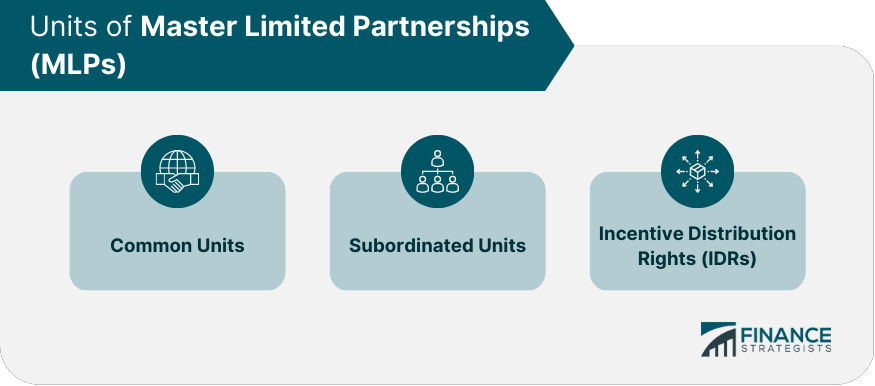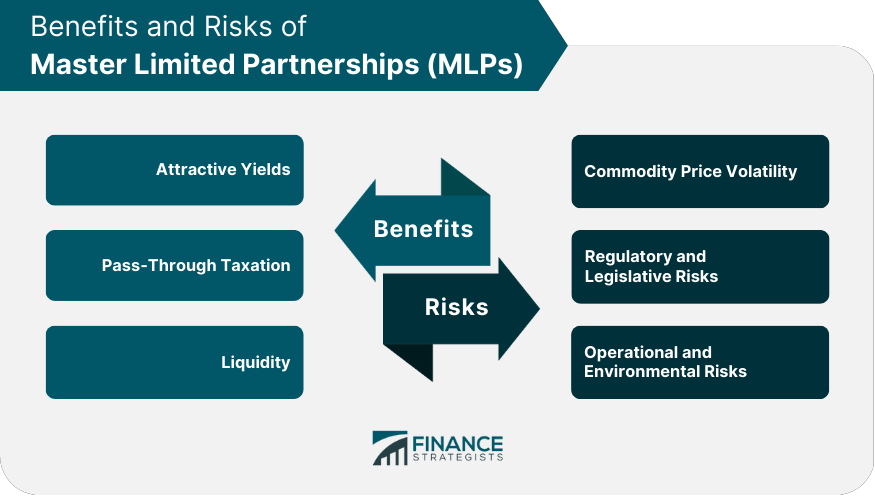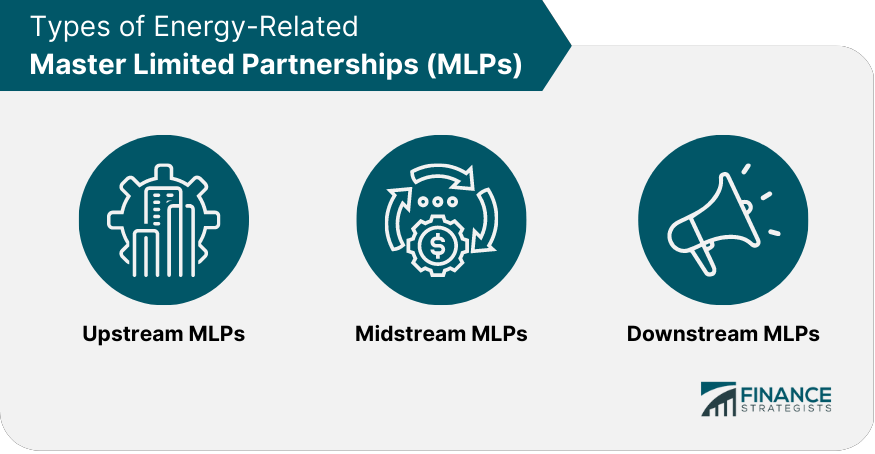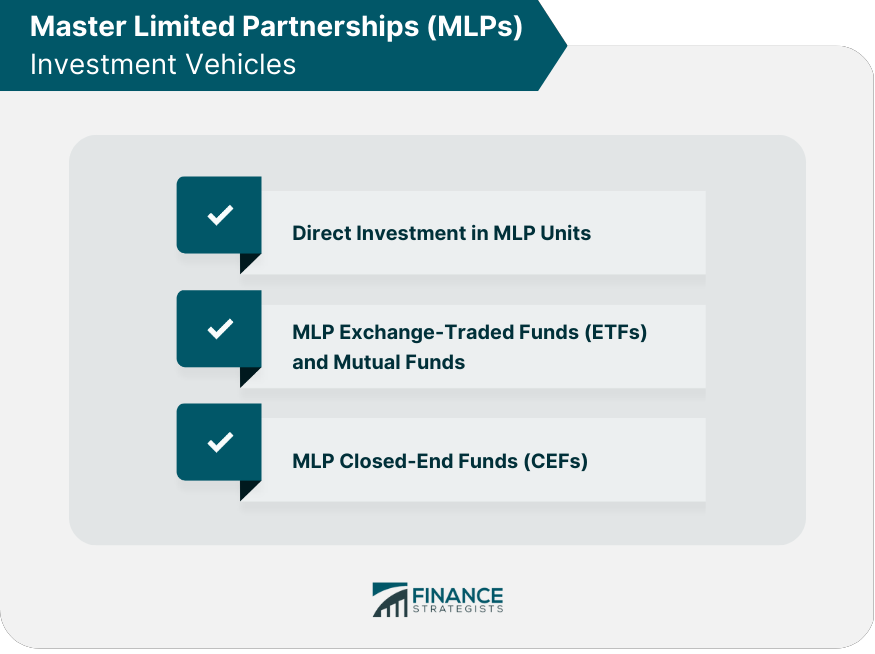Master Limited Partnerships (MLPs) are unique investment vehicles that combine the tax advantages of a partnership with the liquidity of publicly traded securities. MLPs are publicly traded partnerships that offer investors an opportunity to participate in the cash flow and income generated by the partnership's underlying assets. They are primarily used in the energy sector, particularly in the transportation, storage, and processing of oil and natural gas. MLPs originated in the early 1980s as a result of changes in the U.S. tax code, which allowed certain types of partnerships to be publicly traded without being subject to double taxation. Over the years, MLPs have evolved to become a popular investment option for both individual and institutional investors seeking income and growth potential. The primary benefits of MLPs include attractive yields, pass-through taxation, and liquidity. However, they also come with certain drawbacks, such as exposure to commodity price fluctuations and potential regulatory risks. Understanding the structure and components of MLPs is crucial for investors who want to make informed decisions. This section explores the roles of general and limited partners, the different types of MLP units, and the tax implications of investing in MLPs. The MLP structure consists of a general partner (GP) and limited partners (LPs). The GP manages the partnership's operations and has decision-making authority, while the LPs provide capital and receive a share of the partnership's income. The GP typically holds a 2% ownership interest in the MLP and is compensated through management fees and incentive distribution rights. MLP units represent ownership interests in the partnership and are publicly traded on stock exchanges. There are three main types of MLP units: Common Units: These units represent the most common form of equity ownership in an MLP. Investors in common units are entitled to receive distributions based on the partnership's available cash flow. Subordinated Units: These units are typically held by the GP or its affiliates and are subordinate to common units with respect to distributions. In the event the MLP does not generate enough cash to cover distributions, subordinated units may not receive distributions. Incentive Distribution Rights (IDRs): IDRs are held by the GP and entitle the holder to receive an increasing percentage of the partnership's cash flow as certain distribution targets are met. Below are benefits of investing in Master Limited Partnerships: One of the main benefits of investing in Master Limited Partnerships is their attractive yields, often higher than those of traditional stocks or bonds. The stable cash flows generated from the transportation, storage, and processing of oil and natural gas allow MLPs to distribute a significant portion of their earnings to investors in the form of regular cash distributions. These distributions can provide a reliable income stream, making MLPs particularly appealing to income-seeking investors, such as retirees or those looking to diversify their income sources. Another significant benefit of investing in MLPs is their pass-through taxation structure. Unlike corporations, which are subject to double taxation (taxed at both the corporate and shareholder levels), MLPs are taxed only once at the investor level. This tax advantage allows investors to retain a larger portion of the income generated by the partnership, potentially enhancing the overall returns on their investment. Additionally, a portion of the MLP distributions may be classified as a return of capital, further reducing the investor's current tax liability and deferring taxes on that portion until the investment is sold. Master Limited Partnerships offer investors the advantage of liquidity, as MLP units are publicly traded on stock exchanges like traditional stocks. This liquidity makes it easier for investors to buy and sell MLP units without significantly impacting the market price, providing greater flexibility in managing their investment portfolios. The ability to easily trade MLP units can be particularly beneficial during periods of market volatility or when an investor needs to rebalance their portfolio, access cash, or respond to changing financial needs or goals. Investing in MLPs comes with certain risks and challenges, such as: MLPs, especially those operating in the upstream segment, can be significantly impacted by fluctuations in oil and natural gas prices. Changes in regulations and tax laws may affect the profitability and viability of MLPs. It is essential for investors to stay abreast of these changes and understand how they might impact their MLP investments, as well as explore potential strategies to navigate any regulatory shifts. MLPs involved in the extraction, transportation, and processing of energy resources face potential operational and environmental risks, such as accidents, spills, and equipment failures. MLPs are most commonly found in the energy sector, where they play a critical role in the transportation, storage, and processing of oil and natural gas. This section provides an overview of the prevalence and market size of energy-related MLPs, as well as the major players in the industry. The energy sector is the largest and most established market for MLPs. As of 2021, there were over 100 MLPs trading on U.S. stock exchanges, with a combined market capitalization of over $350 billion. Energy-related MLPs can be broadly categorized into three groups based on their primary operations: Upstream MLPs: These MLPs are involved in the exploration, development, and production of oil and natural gas. Upstream MLPs are exposed to greater commodity price risk due to their dependence on the market prices of these resources. Midstream MLPs: These MLPs focus on the transportation, storage, and processing of oil and natural gas. They typically generate stable cash flows through long-term contracts and fee-based revenue structures, making them less sensitive to commodity price fluctuations. Downstream MLPs: Downstream MLPs are involved in the marketing, distribution, and retail sale of refined petroleum products and natural gas. Their revenues are influenced by refining margins and the overall demand for energy products. Some of the largest and most well-known MLPs in the energy sector include Enterprise Products Partners (NYSE: EPD), Energy Transfer (NYSE: ET), and Magellan Midstream Partners (NYSE: MMP). These MLPs have demonstrated strong performance and distribution growth over time, making them popular investment choices for income-seeking investors. When evaluating MLP investments, investors should consider several factors, including: Key financial metrics such as distribution coverage ratio, debt-to-equity ratio, and return on invested capital can help investors gauge the financial health and performance of an MLP. Investors should also consider the overall health of the energy sector and broader economic trends that may impact MLP performance. A consistent track record of distribution growth and stability can indicate a well-managed MLP with strong cash flow generation capabilities. Investors can gain exposure to MLPs through several investment vehicles, including: Investors can purchase individual MLP units on stock exchanges, providing direct ownership and income potential. These funds provide diversified exposure to a basket of MLPs, offering investors the benefits of diversification and professional management. Similar to ETFs and mutual funds, MLP Closed-End Funds (CEFs) invest in a diversified portfolio of MLPs. However, CEFs trade on stock exchanges like individual stocks and can trade at a premium or discount to their net asset value. Master Limited Partnerships are publicly traded partnerships that provide investors with the opportunity to participate in the cash flow and income generated by the partnership's underlying assets, primarily in the energy sector.Definition of Master Limited Partnerships (MLPs)
Structure and Components of MLPs
General Partner and Limited Partner Roles
MLP Units

Benefits of Master Limited Partnerships (MLPs)
Attractive Yields
Pass-Through Taxation
Liquidity
Risks and Challenges of Master Limited Partnerships (MLPs)
Commodity Price Volatility
Regulatory and Legislative Risks
Operational and Environmental Risks

MLPs in the Energy Sector
Prevalence and Market Size
Types of Energy-Related MLPs

Major Players and Examples
Assessing MLP Investment Opportunities
Financial Performance Metrics
Industry and Economic Factors
Distribution Growth and Stability
MLP Investment Vehicles
Direct Investment in MLP Units
MLP Exchange-Traded Funds (ETFs) and Mutual Funds
MLP Closed-End Funds (CEFs)

Final Thoughts
MLPs offer investors attractive yields, pass-through taxation, and liquidity, but also come with certain risks and challenges, such as exposure to commodity price fluctuations and potential regulatory risks.
The structure of MLPs consists of a general partner and limited partners, with MLP units representing ownership interests in the partnership.
MLPs are most commonly found in the energy sector, where they play a critical role in the transportation, storage, and processing of oil and natural gas.
When evaluating MLP investments, investors should consider several factors, including financial performance metrics, industry and economic factors, and distribution growth and stability.
Investors can gain exposure to MLPs through several investment vehicles, including direct investment in MLP units, MLP exchange-traded funds, mutual funds, and MLP closed-end funds.
To ensure a well-informed and tailored investment strategy, it is highly recommended to consult with tax services on the dynamic landscape of MLPs and the broader energy market.
Master Limited Partnerships (MLPs) FAQs
Master Limited Partnerships (MLPs) are publicly traded partnerships that combine the tax advantages of a partnership with the liquidity of publicly traded securities. Unlike traditional partnerships, MLPs trade on stock exchanges and offer greater liquidity. Unlike corporations, MLPs enjoy pass-through taxation, meaning income is only taxed once at the investor level.
MLPs are primarily found in the energy sector due to the capital-intensive nature of the industry and the need for significant investment in infrastructure. The stable, fee-based cash flows generated by the transportation, storage, and processing of oil and natural gas make MLPs an attractive investment option for income-seeking investors.
The main tax advantage of investing in MLPs is their pass-through taxation structure, which allows income to be taxed only once at the investor level. This eliminates the double taxation typically associated with corporations, where income is taxed at both the corporate and shareholder levels.
Investing in MLPs comes with certain risks, such as commodity price volatility, regulatory and legislative risks, and operational and environmental risks. Changes in oil and natural gas prices, regulatory environments, and potential accidents or equipment failures can impact the profitability and viability of MLPs.
Investors can gain exposure to MLPs through various investment vehicles, including direct investment in MLP units, MLP Exchange-Traded Funds (ETFs) and Mutual Funds, and MLP Closed-End Funds (CEFs). It is recommended to consult with a wealth management professional to help assess individual financial goals and risk tolerance when considering investments in MLPs.
True Tamplin is a published author, public speaker, CEO of UpDigital, and founder of Finance Strategists.
True is a Certified Educator in Personal Finance (CEPF®), author of The Handy Financial Ratios Guide, a member of the Society for Advancing Business Editing and Writing, contributes to his financial education site, Finance Strategists, and has spoken to various financial communities such as the CFA Institute, as well as university students like his Alma mater, Biola University, where he received a bachelor of science in business and data analytics.
To learn more about True, visit his personal website or view his author profiles on Amazon, Nasdaq and Forbes.











